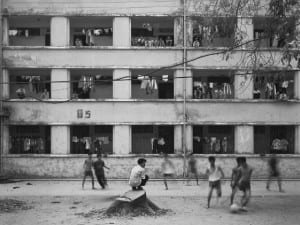Don’t let the title, Elegance in an Age of Crisis: Fashions of the 1930s, fool you. These calm, classically proportioned clothes have nothing to say about social or economic upheaval. They’re pretty things for privileged people: glorious examples of sewing, draping, and pattern-making done during a decade of fascism, depression, and civil war. Here is the proof that Nero fiddled while Rome burned.
Forgoing social history in favor of aesthetics, Elegance in an Age of Crisis is the kind of object-based exhibition that sends connoisseurs into swoons. Patricia Mears, deputy director of The Museum at FIT, and her co-curator, menswear scribe G. Bruce Boyer, have assembled examples of the elegant restraint espoused by the international set who bought their clothes in places like Paris, Havana, and Shanghai—or, in the case of the menswear that makes up 45 percent of this show, from London, Vienna, and Naples. As Mears says: “This is not a show about breadlines.”
You are meant to marvel at the hundreds of pintucks on a chiffon negligée by Hélène Yrande and admire the lace insets patterning a frock from Madeleine Vionnet. You are intended to learn how lighter fabrics and wider looms enabled inventive bias cuts. And understand how the top-end menswear of that time came to be tailored with less bulk than ever before. “The 1930s were a period of technical innovation,” explains Mears. “This is craftsmanship at a level of high art . . . when the point of creating clothes was to make something beautiful.”
Regular museumgoers will be cheered to hear that Mears makes her point with pieces they probably haven’t seen before—many taken from The Museum at FIT’s own collection of over 50,000 garments and accessories. Women’s wear includes the work of Alix, Louiseboulanger, Elizabeth Hawes, Muriel King, Valentina, and Bernard Newman, who interrupted his long career as in-house designer at Bergdorf Goodman with a mid-1930s stint designing costumes for RKO. As Mears says, “We’re telling some quiet stories here.”
Among those, the breakout story is Augustabernard, an all-but-forgotten couturière of the 1920s and early 1930s who inspired Paris-based Vogue editor Main Bocher to elide his own name and turn to fashion design instead of fashion editing. Once renowned for gowns so streamlined that they made Chanel look fussy by comparison, she is represented here by simple-seeming evening dresses constructed with methods Mears describes as “mind-blowing.”
Her masculine counterpart is Vincenzo Attolini, a name that will be new to audiences unfamiliar with Neapolitan tailoring. Boyer credits Attolini, cutter at an Italian firm that called itself London House, with freeing men from the heavily padded and canvassed construction of earlier eras. But Boyer also contradicts himself by showing pieces that prove plenty of others were doing the same thing at the same time: including an example from Frederick Scholte, best known for creating relatively unconstructed jackets for the Prince of Wales from 1919 onward; and showing a specimen of the Palm Beach Suit, a brand of unlined and unconstructed ready-to-wear that appeared during World War I and was widely worn for decades afterward.
It’s not the only instance where editing might have helped. In addition to its evening wear, the exhibition stages mise-en-scènes of a couture atelier, a man’s tailor, a lady’s boudoir, and a man’s dressing room; plus a section on activewear; and another that includes gorgeous Shanghai-made qipaos that don’t seem to have much in common with the other clothes aside from being elegant and expensive.
Less might have been more. Especially to demonstrate the curators’ thesis that “the concept of modern clothing hails from this date.” There are natural waistlines, lighter construction, and body-skimming clothes aplenty, but they sometimes get lost among so many distracting—albeit charming—details. Nevertheless, as Mears herself says: “There’s something very satisfying about a show where every object is beautiful.”
Mary Lisa Gavenas
On show until 19 April, The Museum at the FIT, Seventh Avenue at 27th Street, New York, New York 10001-5992, T: + 1 (212) 217-4558, www.fitnyc.edu/museum





